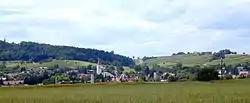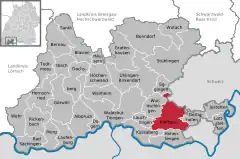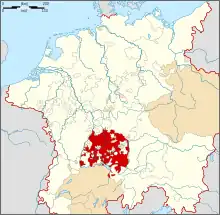Klettgau
Klettgau (High Alemannic: Chleggau) is a municipality in the district of Waldshut in Baden-Württemberg, Germany. It is the centre of the Klettgau historical region stretching across the Swiss border into the cantons of Aargau, Schaffhausen and Zürich.
Klettgau | |
|---|---|
 View of Erzingen | |
 Coat of arms | |
Location of Klettgau within Waldshut district  | |
 Klettgau  Klettgau | |
| Coordinates: 47°39′30″N 08°25′22″E | |
| Country | Germany |
| State | Baden-Württemberg |
| Admin. region | Freiburg |
| District | Waldshut |
| Government | |
| • Mayor (2016–24) | Ozan Topcuogullari[1] |
| Area | |
| • Total | 45.87 km2 (17.71 sq mi) |
| Elevation | 409 m (1,342 ft) |
| Population (2021-12-31)[2] | |
| • Total | 7,638 |
| • Density | 170/km2 (430/sq mi) |
| Time zone | UTC+01:00 (CET) |
| • Summer (DST) | UTC+02:00 (CEST) |
| Postal codes | 79771 |
| Dialling codes | 07742 |
| Vehicle registration | WT |
| Website | www.klettgau.de |
The municipal area includes the villages of Bühl, Erzingen, Geißlingen, Grießen, Rechberg, Riedern am Sand, and Weisweil.
Geography
Klettgau is located on the Klingengraben and Schwarzbach creeks. In the east it borders on the Swiss municipalities of Trasadingen, Wilchingen and Wasterkingen. The neighbouring German municipalities are Wutöschingen, Lauchringen, Küssaberg, and Hohentengen am Hochrhein in the west, as well as Dettighofen in the east. There is a border crossing into Switzerland on the road from Erzingen to Trasadingen.
The municipal area comprises the villages of Bühl, Erzingen, Geißlingen, Grießen, Rechberg, Riedern am Sand, and Weisweil. Erzingen, Bühl and Riedern am Sand are part of the Baden wine region.
History
Erzingen was already mentioned as villa Arcingen in an 876 deed, a Swabian possession held by the Benedictie abbey of Rheinau. In 1486 it was occupied by the forces of the Old Swiss Confederacy on a campaign into the Landgraviate of Klettgau. The immediate landgraviate was inherited by the House of Schwarzenberg in 1687 with their residence in Tiengen, and elevated to a principality by Emperor Leopold I in 1694. After the Schwarzenberg landgraviate was mediatised in 1806, the lordship fell to the Grand Duchy of Baden in 1812.
The present-day municipality was established in a 1971 administrative reform. Bühl and Geißlingen were incorporated in 1975.
Habsburg Rule
The Habsburgs began to rule over the County of Klettgau when Radbot of Klettgau most likely inherited it he ended up reigning over Klettgau from 991-1045, he was then succeeded by his son; Werner I, Count of Klettgau who reigned over Klettgau from 1045-1096. Otto II, Count of Habsburg reigned over it after his father died, later he was the first Habsburg to rule the count of Habsburg, he ruled Klettgau from 1096-1111. His son; Werner II, Count of Habsburg who ruled over Klettgau from 1111-1167, Werner was succeeded by Albert III, Count of Habsburg 'The Rich', (1167-1199) he was succeeded by Rudolf II, Count of Habsburg. (1199-1232) He was then succeeded by Albert IV, Count of Habsburg (1232-1239) Albert was succeeded by the soon-to-be Holy Roman Emperor Rudolf I of Germany Before becoming emperor Rudolf was titled Rudolf IV, Count of Habsburg. However he would not stay a count, Rudolf was later elected Emperor in 1273 Rudolf later died in 1291. Rudolf Was Succeeded by Another Holy Roman Emperor; Albert I of Germany (1291-1308) His son Albert II, Duke of Austria (1308-1358) His Successor Rudolf IV, Duke of Austria (1358-1386) Inherited the title of Klettgau, Albert, II's son Leopold III, Duke of Austria (1365-1386) Inherited Rudolfs titles after his death in 1365. Later during his reign he lost Klettgau and other Swiss holdings as well as his life in the Battle of Sempach which took place in 1386. The death of Leopold, III was followed by Switzerland taking all of his holdings in the region including Klettgau, but later the Swiss agreed to give the lands north of the modern Swiss border to the Habsburgs during the treaty. but Klettgau was under Swiss Influence so this will count as the end of the Rule of the Habsburgs over Klettgau.
Politics
Seats in the municipal assembly (Gemeinderat) as of 2009 local elections:
Demographics
Population development:[3]
|
Economy
Business
- Bucher Hydraulics, founded 1923
Transport
Railway station
Klettgau has a railway station located very close to the border with Switzerland, in Erzingen. The station building was completed in 1863.
The railway line from Erzingen to Schaffhausen was electrified and tracks along almost the entire route were doubled, allowing for more frequent services to run. The electrification of the line from Erzingen to Waldshut as well as from Waldshut on to Basel Badischer Bahnhof has also been agreed on and is planned.[4][5]
The station is a border station and as such is in local transport tariff zones in both Germany and Switzerland.
Customs
Erzingen is, for customs purposes, a border station for passengers arriving from Switzerland. Customs checks may be performed in Erzingen station or on board trains by German officials. Systematic passport controls were abolished when Switzerland joined the Schengen Area in 2008.[6][7]
International relations
Klettgau is twinned with:
Notable people
- Maximilian Stoll (1742–1787), physician
- Radbot, Count of Klettgau (c. 985 – 1045)
References
- Aktuelle Wahlergebnisse, Staatsanzeiger, accessed 15 September 2021.
- "Bevölkerung nach Nationalität und Geschlecht am 31. Dezember 2021" [Population by nationality and sex as of December 31, 2021] (CSV) (in German). Statistisches Landesamt Baden-Württemberg. June 2022.
- "Gemeinde von KLETTGAU: Bevölkerungsbilanz, Bevölkerungsentwicklung, Sterblichkeitsrate, Geburtenrate, Migrationsrate". ugeo.urbistat.com. Retrieved 2023-05-23.
- "Waldshut-Tiengen: Einigung bei Elektrifizierung der Hochrheinbahn". 8 March 2016.
- "Hochrheinbahn: Deutsche Bahn beim Ausbau weiter im vereinbarten Zeitplan".
- "Switzerland's Schengen entry finally complete". 27 March 2009.
- "Land borders open as Switzerland enters Schengen zone". 12 December 2008.
External links
- (in German) Municipal website
